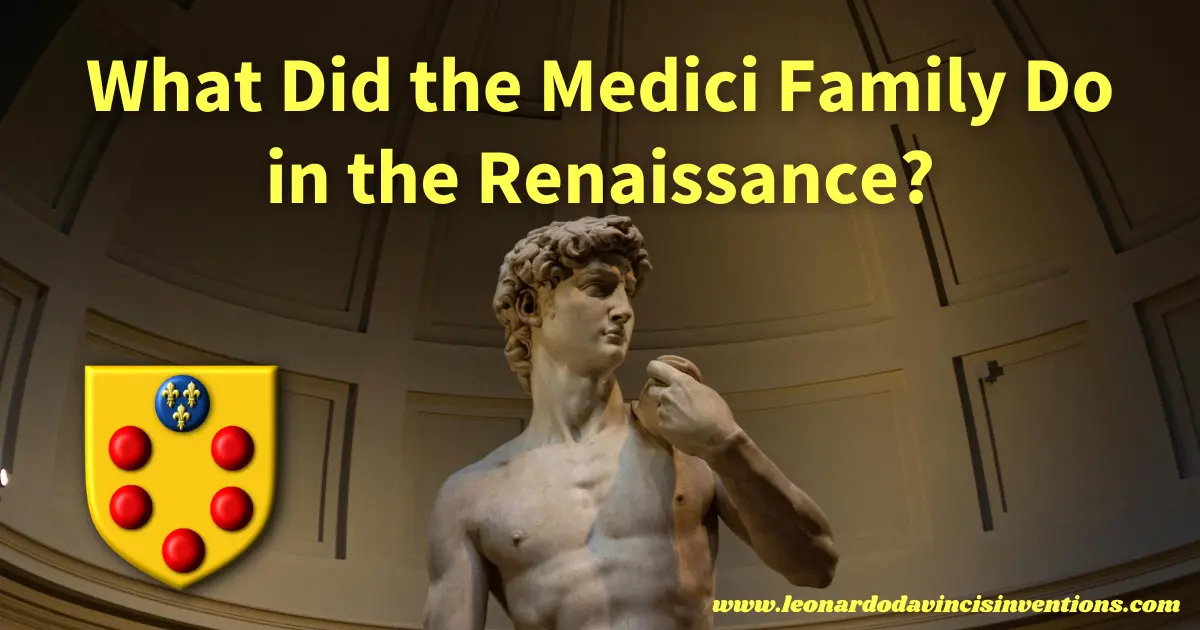
The Medici family Renaissance story is filled with power, influence, and art. Many people feel confused about what made this wealthy Florentine family so important, but you can learn how their choices shaped history.
By exploring their patronage, politics, and famous family members, you’ll discover new details to help you understand the Renaissance.
The Medici family played a pivotal role in launching and guiding the Renaissance by supporting artists, funding large-scale building projects, and exerting significant influence in Florence.
Their banking success gave them power, which they used to change government, culture, and even religion in Italy.
From painters such as Botticelli and Leonardo to landmarks like the Florence Cathedral, the Medici family’s legacy touches every part of Renaissance Florence.
The Medici Family Renaissance: Rise to Power and Influence in Florence
The Medici family’s ascent relied on their expert banking skills, strategic marriages, and deep ties to Florence’s political scene. Their strong control over commerce allowed them to transform into powerful rulers and patrons of the arts.
The House of Medici: Banking, Wealth, and Political Power
The Medici family began building their fortune with the Medici Bank. This bank became one of Europe’s most trusted and prosperous, handling money for merchants and the papacy.
Successful banking led to vast wealth and influence. The Medici utilized their economic power to secure political positions in Florence, supporting their allies and influencing decisions at the city council.
Their control of finances made them an essential part of Renaissance commerce. They funded public buildings and supported artists.
The family created a network of supporters who helped protect and expand Medici interests.
Medici Rule in Florence: From Commerce to Nobility
With growing wealth and power, the Medici moved from business leaders to rulers. Members of the family held top offices in Florence, serving as unofficial leaders while initially avoiding the titles of king or duke.
The Medici increased their standing by marrying into noble families and supporting causes the public cared about. Their influence extended to the church, with family members becoming popes and shaping religious policy.
This mix of commerce, politics, and noble alliances allowed the Medici to shape Florentine society. Their rule faced plots and conspiracies, but their ability to survive power struggles helped maintain family rule for generations.
The Medici Dynasty’s Role in Shaping Florentine Society
The Medici dynasty ruled and profoundly influenced Renaissance Florence through cultural and social investments. They were leading patrons of the arts, commissioning many works of architecture, sculpture, and painting that still define the city’s landscape.
Their patronage extended to artists like Michelangelo and Leonardo da Vinci, who produced masterpieces that reflected the new ideas of humanism and innovation.
The Medici’s support for science, education, and literature promoted learning and encouraged creativity in Florence.
By supporting cultural rebirth and public works, the Medici’s impact on society was lasting, shaping the culture and legacy of Florence and the Renaissance period.
Patronage and Artistic Innovation: How the Medici Family Funded the Renaissance
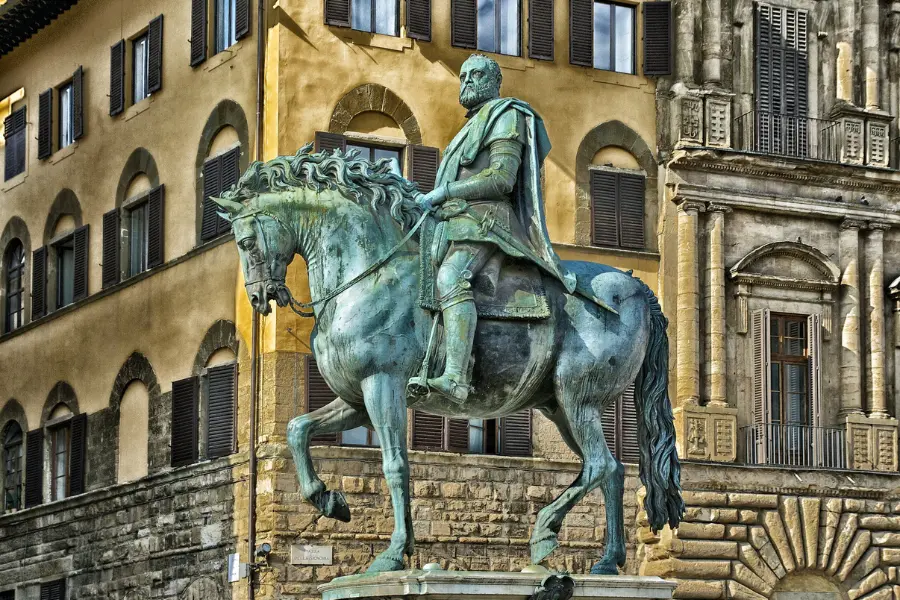
The Equestrian Monument of Cosimo I de Medici, Piazza della Signoria in Florence, Italy
The Medici family’s wealth from banking and commerce transformed Florence into a cultural and innovative hub. They left a powerful legacy that shaped Renaissance society by supporting artists, architects, and scholars.
The Medici Family Renaissance and the Patronage of the Arts
The House of Medici rose to prominence after gaining economic power and political influence in Florence. Their interest in art and humanism pushed the city to the front of the Renaissance movement.
Cosimo de’ Medici, known as Cosimo the Elder, began a tradition of using family wealth to fund works of art, libraries, and schools. The Medici’s patronage was more than a matter of personal taste—it was a means to reinforce their status and expand their influence throughout Florentine society.
The Medici family supported many famous artists, including Botticelli and Michelangelo. They nurtured the careers of those who would define Renaissance culture.
This approach helped form the Medici Patronage Network, which deeply penetrated politics and education.
Sponsorship of Art and Science: Supporting Artists, Architecture, and Literature
Lorenzo de’ Medici expanded the sponsorship of art and science, investing in architecture, sculpture, and literature. The family provided financial backing for artists and scholars who needed resources for their creative and academic projects.
Under the Medici’s rule, Florence became a hub of artistic innovation and scientific learning. They directly funded new buildings such as the Medici Chapel and supported advancements in education and humanism.
The Medici’s role extended beyond art. They gave thinkers like Leonardo da Vinci and Galileo opportunities to work and learn.
This sponsorship fueled a wave of creativity that would ripple across Europe.
Artistic Commissions, Renaissance Art, and the Medici’s Legacy
The Medici’s artistic commissions shaped some of the greatest masterpieces of Renaissance art. By funding paintings, sculptures, and grand architectural projects, the dynasty created a lasting cultural rebirth in Florence.
Their legacy encompasses public works and private collections, many of which have become the foundation for museums and galleries.
Medici contributions ensured that Florence remained a beacon for artists and scholars long after their political power faded.
The Medici Family’s Lasting Impact on Renaissance Culture and Society
The Medici family shaped Florence’s politics, religion, and learning during the Renaissance. Their influence reached across art, science, the Papacy, and even the structure of European society.
Medici Popes, Papacy Influence, and Political Intrigue
Medici power extended deeply into the Catholic Church. Members of the family, including Leo X and Clement VII, became popes, thereby granting the Medici control over both religious and political decisions in Europe.
The Medici used their wealth and connections to help friends and allies gain church offices. They became central figures in significant events, such as the Sack of Rome, and received massive art commissions in Vatican City.
Their time as popes strengthened the Medici’s reputation for political intrigue, alliances, and conspiracies within church leadership. This allowed the family to support artistic projects and influence papal policy at the highest level.
Education, Humanism, and the Medici’s Support of Science
Cosimo and Lorenzo de’ Medici championed education, humanism, and the revival of classical learning. They sponsored scholars who translated ancient texts and opened libraries that made books available to the public.
Their home became a meeting place for philosophers, scientists, and artists. The Medici’s support of science helped spark innovation.
They financially backed thinkers like Galileo and Leonardo da Vinci, laying the groundwork for progress in astronomy, anatomy, and engineering. Their sponsorship helped the Florentine Renaissance become a center of learning.
Medici’s Rise and Fall: Corruption, Conspiracy, and Family Legacy
The family’s rise to power relied on banking, trade, and political maneuvering. The Medici Bank funded much of Florence’s wealth.
Their rule sparked jealousy, leading to conspiracies and attempts on their lives. The Pazzi Conspiracy was a deadly plot against Lorenzo, showing the dangers of their growing power.
Corruption and economic trouble weakened the family by the late 1500s. Yet, their artistic patronage and cultural legacy in Renaissance Florence live in the city’s buildings, paintings, and sculptures.
Despite its downfall, the Medici family remains a symbol of innovation and artistic rebirth in European history.
Frequently Asked Questions
The Medici family significantly influenced Florence during the Renaissance, but their power was marred by controversy, betrayal, and decline. Their story involves political control, art patronage, personal challenges, and changing fortunes.
What was the dark side of the Medici family?
The Medici family was often involved in ruthless politics, financial manipulation, and violence. Some members used bribery and even ordered assassinations to keep their position.
They faced scandals that left a lasting mark on Florence’s history.
Why was the Medici family so powerful?
Their wealth came mainly from banking and finance. The Medici Bank became one of the most successful in Europe.
This money enabled them to influence politics, support the church, and become leading patrons of Renaissance art, thereby gaining control in Florence and beyond. They even became rulers in Tuscany for centuries.
Did the Medici Family Renaissance Really Change History?
The Medici family played a major role in shaping the Renaissance. They supported famous artists such as Michelangelo and Leonardo da Vinci.
Their patronage helped Florence become a center of art, science, and culture. This influence spread and had a profound impact on history.
Does the Medici family still exist today?
The original ruling Medici bloodline ended in the 18th century. Although some people may have Medici ancestry today, none hold official power or titles associated with their former dynasty.
What caused the downfall of the Medici family?
Poor leadership and a loss of financial power led to the Medici family’s decline. Political enemies and other powerful families also contributed to their fall.
Later generations were unable to manage the family wealth and influence as effectively.
Who betrayed the Medici family?
The Pazzi family is infamous for attempting to betray the Medici family. In the Pazzi Conspiracy, they tried to kill Lorenzo de’ Medici and his brother Giuliano during church.
This attack led to Giuliano’s death and caused a major crisis in Florence’s history.
Why did the Medici bloodline end?
The Medici family bloodline ended mainly due to a lack of male heirs in the final generations. The last Medici ruler, Anna Maria Luisa, died in 1743, marking the end of the dynasty.
Is Netflix’s Medici historically accurate?
The Netflix series “Medici” is based on the family’s history and major events. However, it alters some facts and adds drama for entertainment purposes.
Some characters and timelines are inaccurate, so viewers should not rely on them as a primary historical source.
What brought down the Medici family?
Weak leadership and the loss of their banking fortune played a significant role. Competing families and foreign powers also challenged their control.
By the 18th century, they could not maintain their influence or defend their position in Tuscany.
What illness did Medici have?
Several Medici family members had health problems, such as tuberculosis and gout. Some died young from these diseases.
Close marriages within the family may have caused genetic issues.
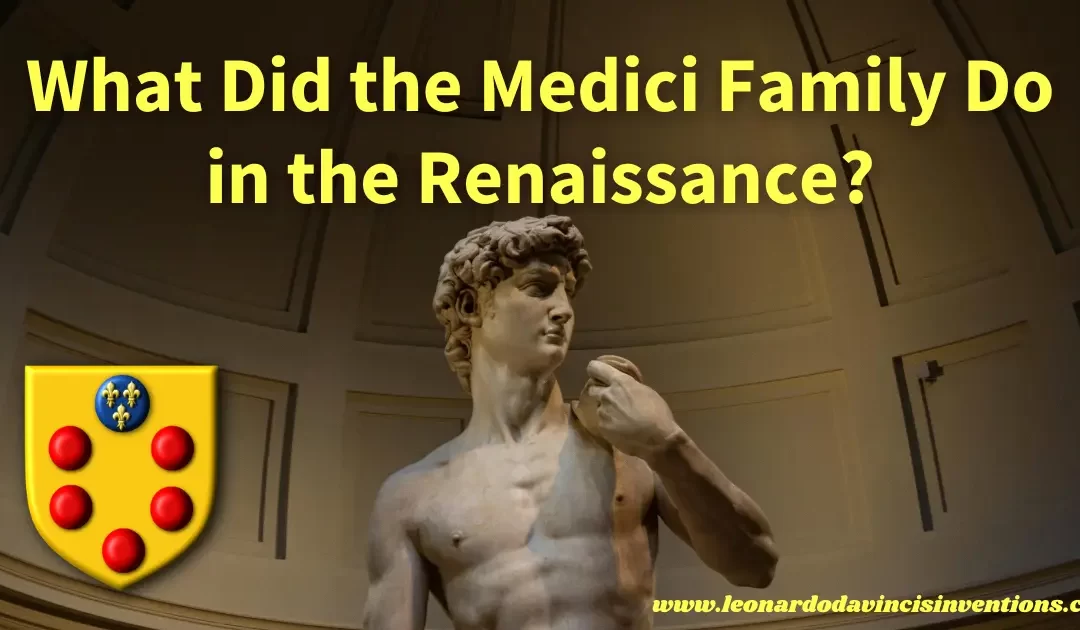
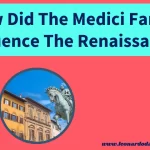
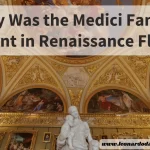
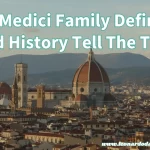
 Leonardo Bianchi,
the creator of Leonardo da Vinci's Inventions.
Thank you for visiting
Leonardo Bianchi,
the creator of Leonardo da Vinci's Inventions.
Thank you for visiting